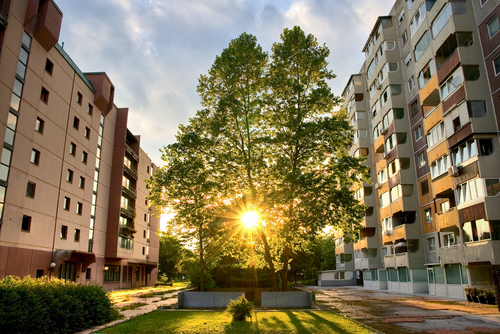 |
In many urban landscapes, we have created a world often devoid of vegetation, one of the key causes of UHIs and one of the top ways to reverse the impacts. Planting trees and other vegetation is perhaps the simplest solution to cooling UHIs because they provide shade and the opportunity for evapotranspiration, helping to dissipate heat. According to the EPA, shaded surfaces can be as much as 20 – 45°F cooler than unshaded areas at peak temperatures and evapotranspiration, on its own or with shading, can cool peak summer temperatures 2 – 9°F.
In addition to cooling the air and surfaces, which also reduces energy use and air emissions, vegetation helps to reduce stormwater runoff, improves water quality, can reduce pavement maintenance, and help to reduce noise, improve aesthetic value, and create habitat for diverse species. In a five-city study of the costs and benefits of urban forestry, the EPA notes that “on a per-tree basis, the cities accrued benefits ranging from about $1.50-$3.00 for every dollar invested.”
Roofs are another huge contributor to UHIs, and in the United States, dark roofing materials have been the norm. Now however, research is looking at “cool roofs” as a mitigation factor. According to the Lawrence Berkeley Laboratory, there are two independent factors that make a roof cool:
1) The ability to reflect sunlight (i.e., solar reflectance or SR), and
2) “Thermal emittance or TE,” or the “efficiency with which a surface cools itself by emitting thermal (or “far”) infrared radiation.”
Need an answer fast? Relax. Our editors guarantee a personalized response to your questions within 3 business days. Take a free trial of Enviro.BLR.com® and see what everyone is talking about. For a limited time, also receive a free 2014 EHS Salary Guide. Download Now.
Cool-roof technology includes white and colored roofs that address both heat reduction and aesthetic needs of the application at hand. For example, white roofing materials are most often used for roofs that cannot be seen from street level, such as flat and low-sloped roofs common on factories and commercial buildings. Clean white roofs reflecting 80% of sunlight will remain about 55°F cooler, compared to gray roofs reflecting only about 20% of sunlight.
White roofing products include:
- Single-ply membranes rolled onto roofs and held in pace with different fasteners,
- Elastomeric coating, a liquid surfacing material available in different colors for different reflectivity requirements,
- Painted metal,
- Ballast that increases the thermal mass of the surface, decreasing heat flux through the roof, and
- Tile.
Colored roofing is used for roofs that are more visible, such as pitched roofs on homes. Like white roofs, colored roofs provide both SR and TE and can help mitigate UHI impacts. According to the EPA, one California study showed annual average net savings for cool roofs can be almost 50 cents per square foot, factoring in such variables as increased winter heating costs, summer energy savings and the longer life spans of cool roofs.
Everything You Need for Environmental Compliance
Enviro.BLR.com puts everything you need at your fingertips, including practical RCRA, CAA, CWA, hazardous waste regulatory analysis and activity, news, and compliance tools. Try it at no cost or risk and get a FREE report.
Combining vegetation and roofs are “green roofs,” or rooftop gardens which can be created to meet a variety of needs from simple groundcover plants to reduce heat to park-like settings complete with trees. According to one 2014 study comparing white, green and black flat roofs in the United States, white roofs are three times more effective than green roofs at cooling the planet, while green roofs can offer more localized benefits of helping to reduce stormwater runoff and provide “natural” urban landscapes.1
Cool pavement represents another huge opportunity for mitigating UHIs via technologies that reflect more solar energy, augment water evaporation and have other cooling properties. The EPA notes that analysis of four geographically diverse cities showed pavement comprises about 30 – 45% of land cover, and conventional paving can hit peak summertime temperatures of 120 – 150°F, heating the air and stormwater runoff. Cool paving technologies include reflective cement concrete and cool-colored coatings for asphalt, both of which can reflect up to 50% of sunlight, as well as cement pavers, and clear resin binders that reveal light-colored, reflective aggregate.
1Sproul J, Wan M-P, Mandel BH, Rosenfeld AH. Economic Comparison of White, Green, and Black Flat Roofs in the United States. Energy and Buildings. 2014;71:20-27.
